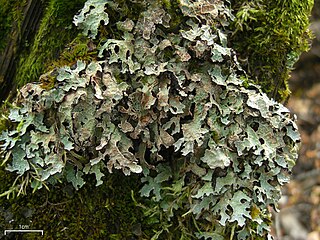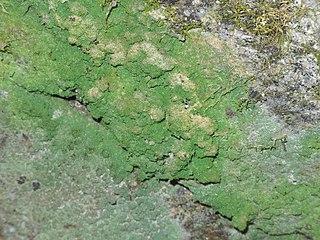
A lichen is a composite organism that arises from algae or cyanobacteria living among filaments of multiple fungi species in a mutualistic relationship. Lichens are important actors in nutrient cycling and act as producers which many higher trophic feeders feed on, such as reindeer, gastropods, nematodes, mites, and springtails. Lichens have properties different from those of their component organisms. They come in many colors, sizes, and forms and are sometimes plant-like, but are not plants. They may have tiny, leafless branches (fruticose); flat leaf-like structures (foliose); grow crust-like, adhering tightly to a surface (substrate) like a thick coat of paint (crustose); have a powder-like appearance (leprose); or other growth forms.

Lichen morphology describes the external appearance and structures of a lichen. These can vary considerably from species to species. Lichen growth forms are used to group lichens by "vegetative" thallus types, and forms of "non-vegetative" reproductive parts. Some lichen thalli have the aspect of leaves ; others cover the substrate like a crust, others such as the genus Ramalina adopt shrubby forms, and there are gelatinous lichens such as the genus Collema.

Parmelia barrenoae is a species of foliose lichen in the large family Parmeliaceae. It was formally described as a new species in 2005. Before this, it was lumped together as one of several lichens in the Parmelia sulcata group—a species complex of genetically distinct lookalikes. Parmelia barrenoae is widely distributed, occurring in Europe, western North America, Africa, and Asia.
Wilketalia is a fungal genus in the family Teloschistaceae. It is monotypic, containing the single species Wilketalia citrinoides, a saxicolous (rock-dwelling) crustose lichen found in the Bolivian Andes.
Phylloblastia is a genus of foliicolous (leaf-dwelling) lichens in the family Verrucariaceae. The genus was circumscribed in 1921 by Finnish lichenologist Edvard August Vainio, with Phylloblastia dolichospora assigned as the type species.

Mastodia is a genus of lichen-forming fungi in the family Verrucariaceae. It has six species.

Botryolepraria is a genus of saxicolous (rock-dwelling), byssoid (cottony) lichens of uncertain familial placement in the order Verrucariales. It has two species. Both species grow in damp conditions, such as on cave walls, particularly in areas with minimal light.
Phylloblastia inexpectata is a species of foliicolous (leaf-dwelling) lichen in the family Verrucariaceae. Found in Europe, it was formally described by lichenologists Emmanuël Sérusiaux, Brian John Coppins, and Robert Lücking. The type specimen was collected by the second author in Dunskey Glen Woods, where it was found growing on the leaves of a Prunus laurocerasus tree growing near a stream. It has also been collected in England, southern Italy, Madeira, and Spain.
Galbinothrix is a fungal genus in the family Chrysotrichaceae. It is monotypic, containing the single species Galbinothrix caesiopruinosa, a corticolous (bark-dwelling) lichen.

Tenuitholiascus is a fungal genus in the monotypic family Tenuitholiascaceae, itself in the order Strigulales. The genus contains a single species, Tenuitholiascus porinoides, a foliicolous (leaf-dwelling) lichen found in China.
Pertusaria lueckingii is a species of corticolous (bark-dwelling), crustose lichen in the family Pertusariaceae. Found on the Galápagos Islands, it was formally described as a new species in 2015 by Frank Bungartz, Alan W. Archer, and John Elix. The type specimen was collected on Floreana Island, where it was found growing on the bark of a south-exposed trunk of Cedrella odorata. The species epithet honours German lichenogist Robert Lücking, "who first recognized this taxon as an independent species".
Coenogonium barbatum is a species of foliicolous (leaf-dwelling) lichen in the family Coenogoniaceae. It is characterised by its distinctive beard-shaped growth, setting it apart from closely related species. Identified and named as a new species in 2006, the lichen has been specifically found at the La Selva Biological Station in Costa Rica. The species name barbatum hints at its beard-like appearance.
Dictyonema krogiae is a species of basidiolichen in the family Hygrophoraceae. It is found in Kenya, where it grows as an epiphyte on trees. It is often found in association with other lichens, such as Parmotrema, and bryophytes, such as Frullania. A main characteristic that distinguishes it from other closely related species is its clearly defined internal layers, including its contrasting dense photobiont layer and a loose lower cortex.
Podotara is a fungal genus in the family Pilocarpaceae. It is a monotypic genus, containing the single species Podotara pilophoriformis, an uncommon foliicolous (leaf-dwelling), crustose lichen that grows on Podocarpus totara, a species of podocarp tree endemic to New Zealand. Both the genus and the species were proposed in 1996.
Anaptychia ethiopica is a species of lichen in the family Teloschistaceae. Found in East Africa, China, and Russia, it was formally described as a new species in 1976 by lichenologists Thomas Douglas Victor Swinscow and Hildur Krog. The type specimen was collected from Mount Bwahit, where it was found growing on moss.
Macroconstrictolumina is a genus of lichen-forming fungi in the family Trypetheliaceae. It has four species.
The Pyrenotrichaceae are a small family of fungi in the order Chaetothyriales. It contains two genera, and a total of six species. The genus Pyrenothrix has two species of bark- or leaf-dwelling lichens, while Neophaeococcomyces has four species of saprobic fungi.
Racoleus is a genus of two species of lichen-forming fungi of uncertain familial placement in the order Capnodiales. Both species of Racoleus are filamentous lichens with Trentepohlia as the photobiont partner. The lichens form thalli in the form of felt-like, blackish-brown cushions that grow under shaded conditions on siliceous rocks.
Tricharia nigriuncinata is a species of foliicolous (leaf-dwelling) lichen in the family Gomphillaceae. It is found in East Africa.





